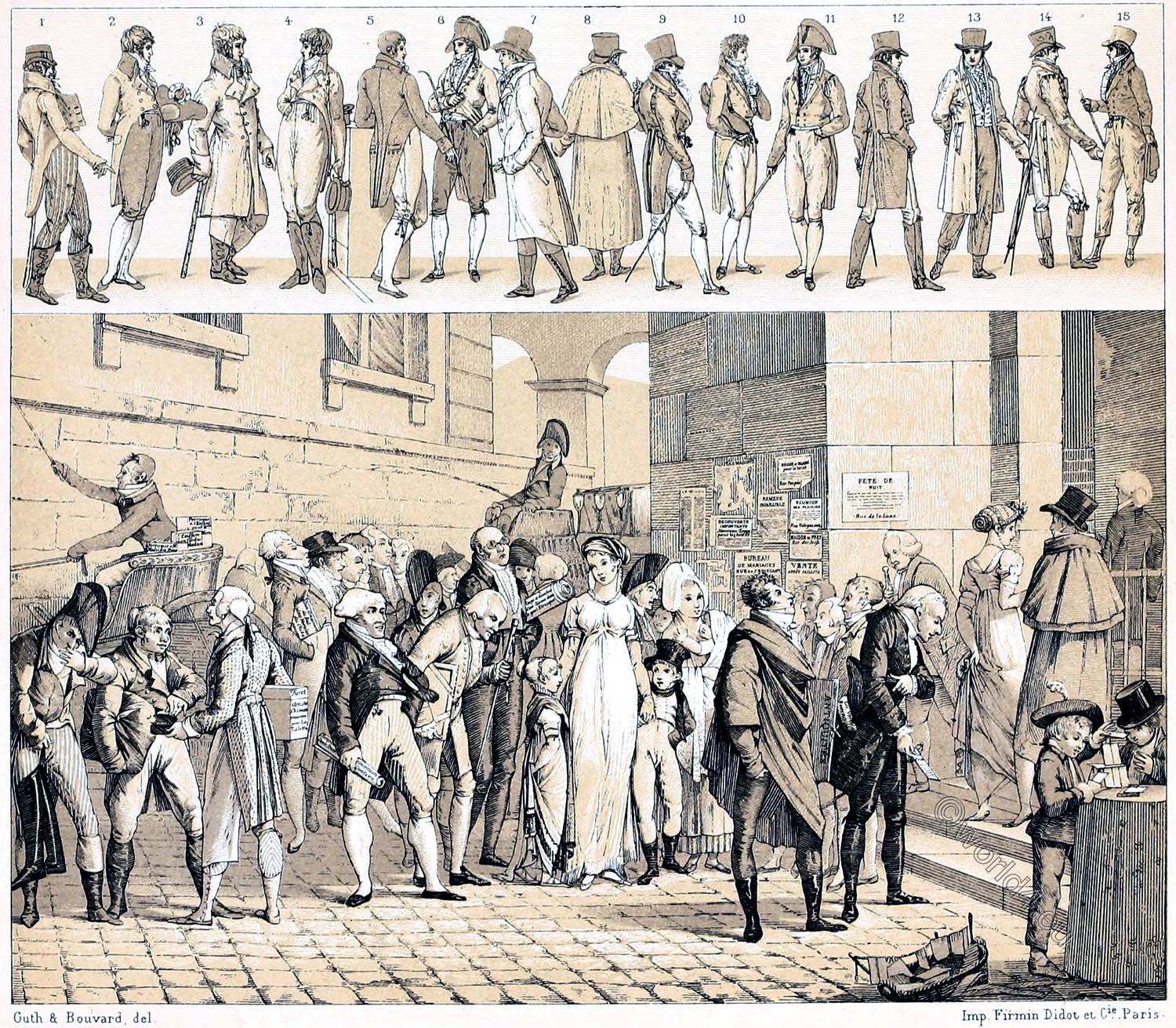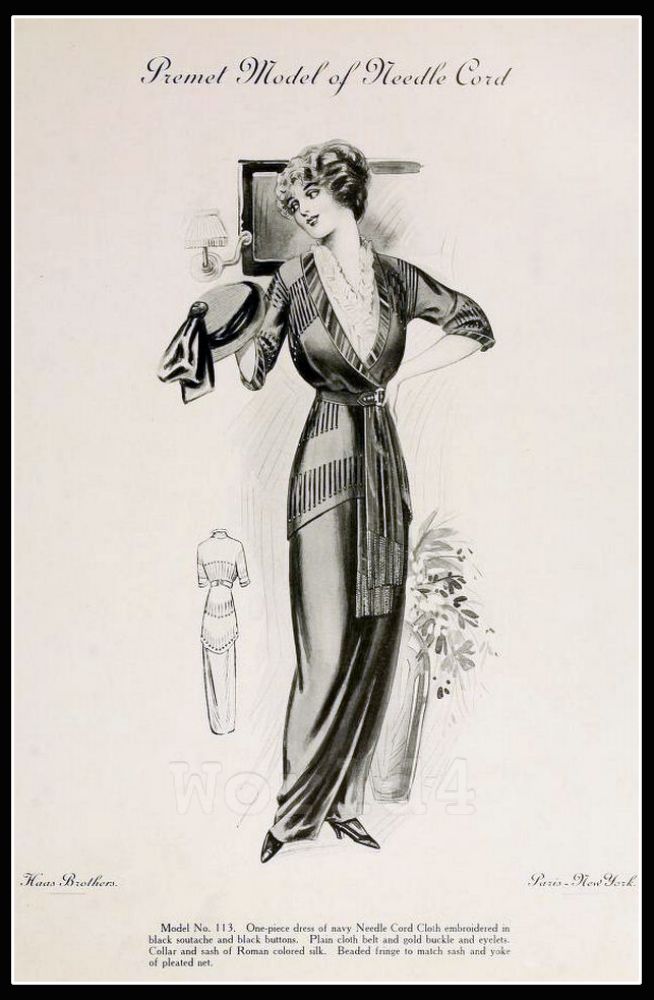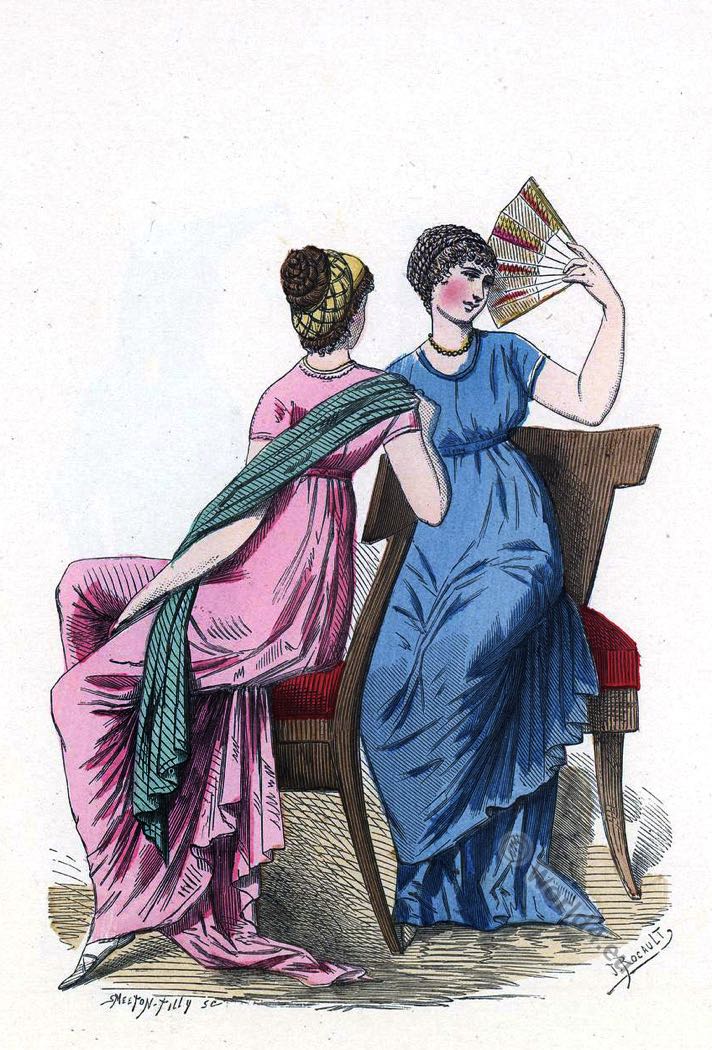FRANCE. COSTUMES OF THE FASHION MASTERS, 1801, 1805.
CLOTHING ACCORDING TO THE PROFESSION.
The morning traffic; the door of a rich man (Debucourt, month Ventose in 13, 1805.
On our panel, one of those coloured engravings with which the bourgeoisie used to decorate their dining rooms, the engraver Debucourt drew a series of clients and petitioners as they used to besiege the door of the rich, painters, musicians, language teachers, writers, scholars and ashamed poor.
We are in the Chaussée d’Antin at about 10 am. A young man is about to climb the stairs. A lady in an antique fashion costume, led by a gentleman in an elegant garrick, is crossing the threshold. Behind her, in the foreground, the poet follows, dressed in black, with a dedication epistle (letter of dedication) in his hand, in his pocket a novel of the “rewarded virtue” *).
At his side, the painter from David’s school of antiquity (classicism) boasts a carefully draped coat. The lady with her three children, the youngest of whom is carried by the nurse, in simple costume, has wisely left her husband at home when she goes to beg. Between her and the nurse appears in the high tricorn the head of one of those allegedly naive people who scatter incense to their bullets with feigned sincerity. Then follow in a row a musician in a blue tailcoat with golden buttons, breeches and escarpins, an old painter with an easel painting under his arm supported by a long stick, and an architect with his latest construction plan.
*) Samuel Richardson, “Pamela” (epistolary novel of 1740). The story of “rewarded virtue” and defended innocence as the social rise of the maid to a bourgeois wife.
Behind the three artists, a number of less specific types, young and old people in the costume of the transition period, walk along.
In the corner on the left, three toilet artists, a shoemaker, a tailor and a dealer in embellishments have come together. The latter is wearing a powdered wig, then a tailcoat with pink lapels and striped stockings.
Behind them, a hairdresser drives past on his Tilbury *) with various boxes. After the boxes are labeled, he goes to the Hôtel of Madame Malvina Fricot.
The coach of the financier, around whose door all these parasites gather, stops in the background.
*) The tilbury is a light horse-drawn carriage, of the cabriolet type, two-wheeled, open, with a bonnet (sometimes without), invented in 1815 in England. It bears the name of the coachbuilder who developed it.
The wall attacks announce public auctions, infallible means, pawnshops, a new boot polish, festivities, balls, concerts, fireworks, etc.
The 15 fashion figures in the upper part of the panel show how, during the period 1801-1805, the follies of the Incroyables’ male costume of 1797 gradually evolved into the simpler modern costume.
Fashion of Directoire and Empire in France, fashion of Regency in England.
The fashion of the dandies.
1801.
- No. 1 – Costume of a young man.
- No. 2 – Company suit.
- No. 3 – Morning costume
- No. 4 – Parisian costume
- No. 5 – Young man’s costume.
1803.
- No. 6 – Large toilet,
- No. 7 – Overskirt à l’ecuyère, waistcoat made of swan fur.
- No. 9 – Parisian costume.
- No. 15 – French costume, English fashion
1804
- No. 8 – Alpaca skirt with hood.
- No. 10 – Tailcoat in Savoyard brown, apricot-coloured trousers.
- No. 12 – Parisian costume.
- No. 13 – Morning costume of a young man
1805.
- No. 11 – Parisian costume.
- No. 14 – Parisian costume.
The figures are taken from the Journal des dames et des modes.
Cf. E. u. J. de Goncourt, L’art du XVIII. siècle. – Delécluze, Louis David, son école et son temps, 1855. – De Jouy, L’Ermite de la chaussée d’Antin, 1812-1814. – Prud’homme, Miroir de l’ancien et du nouveau Paris, 1807.
Source: History of the costume in chronological development by Auguste Racinet. Edited by Adolf Rosenberg. Berlin 1888.
Related
Discover more from World4 Costume Culture History
Subscribe to get the latest posts sent to your email.







